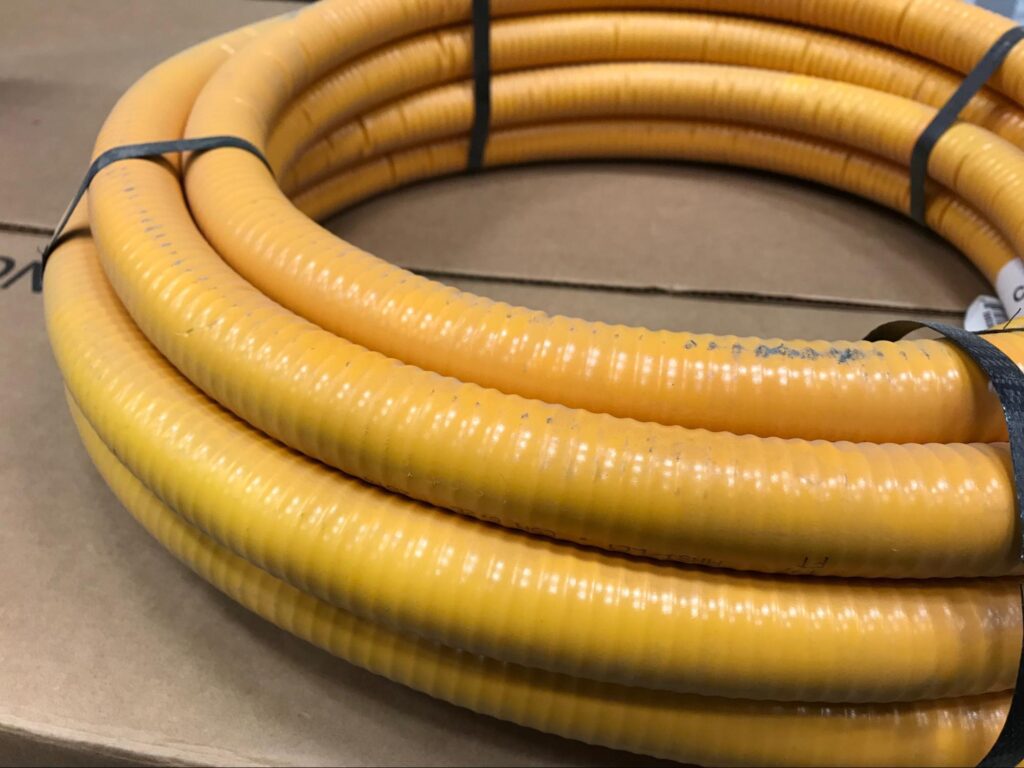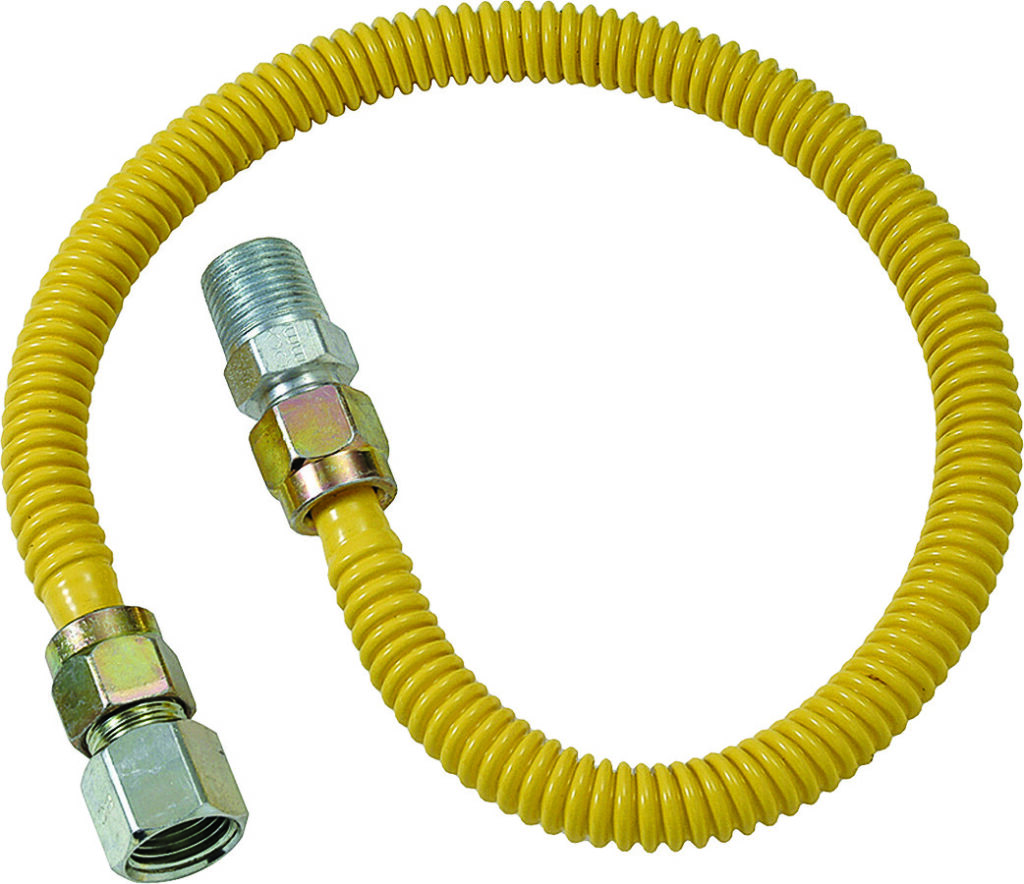Yellow CSST Gas Pipe vs Yellow Gas Connectors: Understanding the Difference

When installing or maintaining a gas system, the materials used for gas piping are crucial for safety, efficiency, and compliance with local codes. Among the most commonly used materials are Yellow CSST Gas Pipe and Yellow Gas Connectors, which often get confused due to their similar appearance. However, they are designed for different applications and have distinct characteristics. Understanding these differences is important for homeowners, contractors, and anyone working with gas systems.
Let’s explore the differences between Yellow CSST Gas Pipe and Yellow Gas Connectors, their features, uses, and why the right selection is so important.
What is Yellow CSST Gas Pipe?

CSST stands for Corrugated Stainless Steel Tubing, a flexible, durable material used for gas piping. The yellow coating that you see on CSST gas pipes serves as a protective layer against corrosion and other environmental factors that could affect the pipe’s performance.
Key Features of Yellow CSST Gas Pipe:
- Flexibility and Ease of Installation: CSST is known for its flexibility, which makes it easier to install in tight spaces or difficult-to-reach areas. It can be bent and maneuvered without the need for additional fittings, reducing installation time and cost.
- Durable and Corrosion-Resistant: The stainless steel core of the pipe is resistant to corrosion, and the yellow coating adds an extra layer of protection, ensuring the pipe remains safe and long-lasting, even in moist environments.
- Use for Main Gas Supply: Yellow CSST gas pipes are commonly used for delivering natural gas to various appliances in a home, such as stoves, dryers, and water heaters. They are often used in both residential and commercial gas systems, allowing flexibility in routing gas lines around the building.
- Pressure Resistance: CSST pipes are designed to withstand the pressures of gas flow, making them a safe and reliable option for handling residential and commercial gas delivery.
What is a Yellow Gas Connector?

Yellow Gas Connectors are flexible, short-length tubes made from corrugated stainless steel tubing (CSST), which is coated with a yellow plastic jacket for additional protection. These connectors are specifically used for connecting gas appliances to the main gas supply line.
Key Features of Yellow Gas Connectors:
- Flexibility: Yellow gas connectors are highly flexible, which allows them to easily accommodate tight spaces and quick installations. They are particularly useful for connecting gas appliances in kitchens, laundry rooms, or anywhere flexibility is required.
- Short Length: Unlike CSST pipes, gas connectors are much shorter in length. They are designed for appliance connections rather than long-distance gas delivery.
- Safety Features: These connectors have built-in safety mechanisms, such as pressure relief and flow control, to prevent leaks and ensure the system works properly.
- Made of CSST: Although they are also made from corrugated stainless steel, their flexibility and short length make them ideal for final appliance hookups.
Yellow CSST Gas Pipe vs Yellow Gas Connectors: Key Differences
1. Purpose and Use:
- Yellow CSST Gas Pipe: Primarily used for gas delivery lines running through a building. These pipes transport gas from the meter or main gas line to various appliances throughout the home or commercial property.
- Yellow Gas Connectors: Designed specifically for connecting appliances (such as stoves, dryers, or water heaters) to the gas supply line. They are used for the final connection, usually in small lengths.
2. Material and Construction:
- Yellow CSST Gas Pipe: Made from corrugated stainless steel tubing coated with a yellow protective layer, which helps prevent corrosion. CSST pipes are flexible but are used for longer gas line runs.
- Yellow Gas Connectors: Made from the same material as CSST, these connectors are also corrugated and coated with yellow plastic, but they are more flexible and intended for short, flexible connections between gas appliances and the main gas supply.
3. Length and Flexibility:
- Yellow CSST Gas Pipe: Typically comes in long coils and is designed for longer installations that may require some degree of flexibility but are often routed in a more permanent way through walls or ceilings.
- Yellow Gas Connectors: Shorter in length and much more flexible, designed for the final appliance connection. These connectors can easily bend to fit around obstacles or tight spaces.
4. Installation and Application:
- Yellow CSST Gas Pipe: Installed as the primary piping system that carries gas through the building. It is typically used for longer runs, making it ideal for the main gas supply lines.
- Yellow Gas Connectors: These connectors are used only for appliance connections, typically in areas where appliances need to be easily hooked up to the gas line (e.g., kitchens or laundry rooms).
5. Safety and Code Compliance:
- Yellow CSST Gas Pipe: When installed correctly, CSST is safe and compliant with most building codes. Proper grounding and bonding are required to ensure safety from electrical hazards. CSST requires attention to detail when it comes to installation and protection against electrical faults.
- Yellow Gas Connectors: Also safe when installed correctly but are not intended to be used as the main gas line. Like CSST gas pipes, they must be properly connected to prevent gas leaks and meet local code requirements.
Why the Right Selection is Important
Both Yellow CSST Gas Pipe and Yellow Gas Connectors play essential roles in a gas system, but selecting the correct one for each application is vital for ensuring the system operates safely and efficiently.
- CSST Gas Pipe: Should be used for long gas line runs through a home or building. Its flexibility makes it a versatile option for routing gas lines in difficult-to-reach spaces, but it is not meant for final appliance connections. Installing CSST properly ensures safety, gas pressure regulation, and system longevity.
- Gas Connectors: Designed specifically for connecting appliances to the gas supply, these connectors make it easy to hook up appliances without complicated fittings. They provide the flexibility needed for quick and safe connections, but they are not suited for main gas delivery.
Using the right type of pipe or connector for each task ensures that your gas system is safe, compliant, and efficient. If you’re unsure which product is right for your installation or need help ensuring proper installation, it’s always a good idea to consult a professional plumber or contractor with expertise in gas piping systems.
Conclusion
Although Yellow CSST Gas Pipe and Yellow Gas Connectors may look similar at first glance, they are designed for very different applications in a gas delivery system. The CSST pipe is intended for long-distance gas transportation, offering flexibility and durability for routing gas throughout a building. In contrast, the yellow gas connectors are flexible, short connections used for safely linking gas appliances to the main line.
By understanding the differences between these two materials, you can ensure that your gas system is set up correctly and meets the necessary safety standards. Always make sure to follow building codes and consult with a professional when installing or maintaining any part of your gas system. Safety is key, and proper installation can help prevent leaks, pressure issues, and other hazards down the road.

